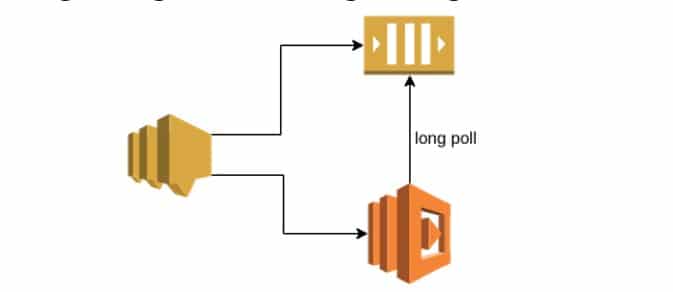

Leverage existing retry logic and dead letter queues. Simply put, SQS triggers: Trigger a Lambda function when on or when messages have been placed in the queue. The Lambda service does all of this for me now. It helps with keeping things moving in the queue when sending too many messages to the dead-letter queue. Common usage patterns Broadcasting events to a pool of servers. I’m no longer responsible for polling SQS queues and triggering Lambda function when queue activity is detected. It is critical to set the "MaxReceive" count to balance for high concurrency. The ideal approach is to set your visibility timeout to 6 times the function timeout. This raises the possibility of duplicate message processing. Those messages will need to be processed again, increasing queue size. Unprocessed messages become visible if the visibility timeout expires before the Lambda function processes them. If it happens frequently, Lambda slows polling, causing a queue blockage. If you choose a batch size that is too big, your Lambda function may timeout. The Lambda service will reduce the number of processes polling the queue on Lambda function failures.įailures are placed in the dead-letter queue and deleted from your SQS queue. Unless otherwise specified, the maximum concurrency is 1000. Lambda will keep adding processes per minute until the queue slows or hits capacity. That implies it will call more Lambda functions concurrently. If the Lambda service detects an increase in queue size, it raises batch size. To prevent having your Lambda function throttled, make sure the reserved concurrency is at least five. These five simultaneous processes indicate Lambda is calling your Lambda function five times. Lambda automatically uses five parallel processes to clear the queue. collaborates with Amazon Web Services to deliver digital training content to our students.

Serverless Examples AWS Serverless Exercises AWS Serverless Quiz Message AWS Failure Management AWS Errors Sync & Async AWS Error Stream-Based AWS Failed-events AWS Error Handling SQS AWS Error Summary AWS Failure Steps AWS Dead-Letter Queues AWS X-Ray Tracing AWS Migrating To Serverless AWS Fargate AWS Business Data Needs AWS SNS Filtering AWS SL Automation AWS Web And Mobile Apps AWS Serverless At Scale AWS Concurrency AWS Scaling API Gateway AWS Scaling SQS AWS Scaling Lambda Lambda Power Tuning Lambda Environment AWS SL Scaling Databases AWS SL Scaling RDBM Scaling Step Functions AWS Scaling Kinesis AWS Testing Peak Load AWS SL Securing AWS Data Protection AWS SL Monitoring AWS X-Ray AWS X-Ray Demo AWS CloudTrail & Config AWS SL Deployments AWS SL Developer AWS Sharing Config Data AWS Deployment Strategies AWS Auto-Deployment AWS SAM Deployment Serverless Wrap Up You can use Amazon Web Services SDKs to access Amazon SQS using your favorite programming language.AWS Serverless SL HOME AWS SL Intro AWS Thinking Serverless AWS Event Submission AWS Workflow AWS Client Polling Pattern AWS Webhook SNS AWS API Gateway AWS AppSync AWS Claim Check AWS Data Processing AWS Kinesis vs. Amazon SQS moves data between distributed application components and helps you decouple these components.įor information on the permissions you need to use this API, see Identity and access management in the Amazon SQS Developer Guide. Client #Ī low-level client representing Amazon Simple Queue Service (SQS)Īmazon SQS is a reliable, highly-scalable hosted queue for storing messages as they travel between applications or microservices. Toggle table of contents sidebar SQS # Client # class SQS.


 0 kommentar(er)
0 kommentar(er)
